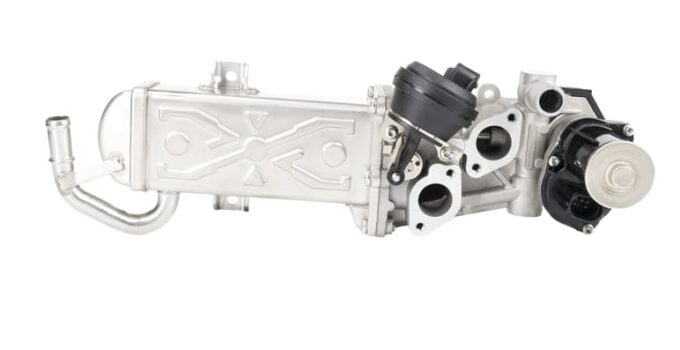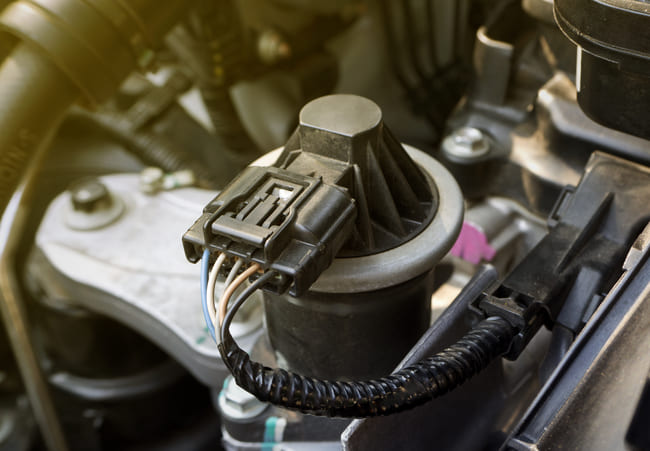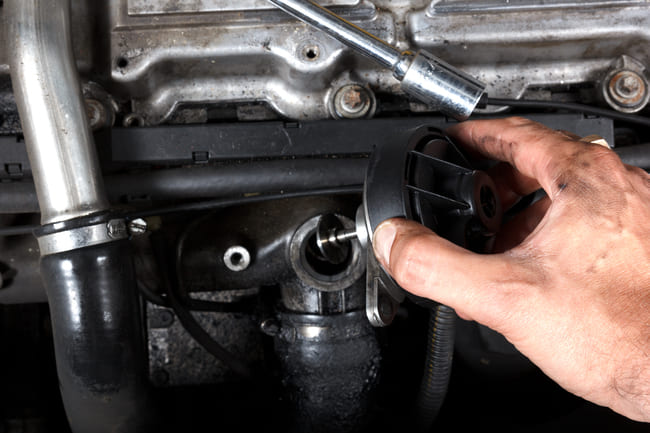
Exhaust gas recirculation ensures that the nitrogen oxides (NOx) emitted are reduced. This system has an important function in diesel engines in particular, because these initially have higher nitrogen emissions due to the fuel. This could hardly be reduced with just exhaust gas aftertreatment with justifiable effort in such a way that the applicable limit values could be met. In addition, exhaust gas recirculation also supports petrol engines when the load changes, so that their fuel consumption can be reduced, especially when the load is only partial. The most important part of the exhaust gas recirculation system is what is known as the EGR valve. The following article describes the exhaust gas recirculation in a diesel and a petrol engine as well as possible defects in your exhaust gas recirculation.
Contents
- 1 What is the exhaust gas recirculation and what are the functions of your exhaust gas recirculation?
- 2 What is meant by external and internal exhaust gas recirculation?
- 3 What types of EGR-valves are used?
- 4 How do you recognize that your exhaust gas recirculation is defective?
- 5 How do you check an electric EGR valve?
What is the exhaust gas recirculation and what are the functions of your exhaust gas recirculation?
As already described, exhaust gas recirculation – regardless of whether it takes place externally or internally – is about minimizing the nitrogen oxides produced during fuel combustion. The basis for this is the Zeldovich mechanism. From these equations it follows that at higher combustion temperatures in the engine cylinder considerably more nitrogen oxides are formed. This is exploited with external and internal exhaust gas recirculation in that the cylinder combustion temperature is reduced through the targeted supply of exhaust gases. The exhaust gases replace part of the engine intake air, which also reduces the amount of fuel injected in order to achieve complete combustion. The problem here, particularly in diesel vehicles, is that the use of an exhaust gas recirculation valve almost automatically leads to more soot particles being produced as a result of the reduced combustion temperature, which are also emitted. In this case, only the appropriate soot particle filter can provide a certain remedy.
What is meant by external and internal exhaust gas recirculation?

These are the two different ways to channel exhaust gases back into the combustion process. While the external systems require additional engine components, the internal exhaust gas recirculation does not require any additional components. However, the external systems offer the advantage that a cooler can also be integrated into the exhaust gas recirculation in order to increase its effectiveness. The most important component of the external EGR exhaust gas recirculation is a corresponding solenoid valve. In a diesel engine, the combustion exhaust gases must be discharged in the soot particle filter in a precisely dosed manner, which is ensured by the exhaust gas recirculation vacuum control valve in cooperation with the exhaust gas recirculation sensor. This ensures that not only the NOx limit values are complied with, but also that very few soot particles are emitted at the same time.
What types of EGR-valves are used?
There are different variants for controlling the corresponding valve. Electronic pressure converters, mechanical pressure converters and electric-pneumatic pressure converters are used here. When the systems were first developed, the vacuum control valve for your exhaust gas recirculation was mostly mechanical. If, on the other hand, the valve is actuated electrically, then instead of the vacuum-controlled solenoid valve there is an electric drive. Some electric valves of this type have a suitable cleaning mode. This is often activated automatically when you switch off your engine. This is controlled by the engine control unit.
How do you recognize that your exhaust gas recirculation is defective?
If you look at exhaust gas recirculation as a whole, the EGR valve is one of the most sensitive components. In particular, dirt often accumulates there over time. As a result, the included control mechanism fails and the control no longer works properly. As a result, the engine idling fluctuates, the engine performance is reduced or the check engine light is activated. Your engine control unit may activate a so-called emergency program, which is also indicated by the engine warning light lighting up as described above. If you accelerate your car, it may jerk if there is an EGR valve defect. Participation in exhaust gas purification may also increase the amount of nitrogen oxides emitted. Sometimes it also happens that your engine loses some coolant over time. In diesel vehicles, a failure of the EGR solenoid valve leads to an increase in the formation of soot particles. These then have to be held back by the soot particle filter, which also causes it to clog quickly. Accordingly, very expensive consequential damage – for example to the turbocharger – can easily occur on your vehicle. If the vacuum control valve of your exhaust gas recirculation is just dirty, it sometimes just needs to be cleaned. Otherwise, replacing the valve is sometimes comparatively complex, so you should entrust an experienced expert with it. So it is usually necessary to disassemble large parts of the vehicle engine. Ultimately, you have to reckon with costs of around 1,000 euros for the change plus the necessary vehicle parts.
How do you check an electric EGR valve?

The function check and the check for leaks are also very easy with an electric EGR valve. A first step is the visual inspection. The main focus should be on the vacuum lines (kinks, marten bites, etc.). Also important are all electrical connections and plugs, which must also function perfectly. A leak test can be carried out using a manual vacuum pump. A vacuum of 300 mbar is generated in petrol engines and 500 mbar in diesel engines. In general, this pressure must not change in a period of five minutes. In addition, your vehicle's engine will stop or its idling will deteriorate significantly.
Conclusion
The exhaust gas recirculation is addressed by the engine control unit and regulates the emissions in diesel engines. In the case of petrol engines, reducing fuel consumption is the main objective. The EGR valve in particular is therefore one of the most important components of the exhaust system of modern vehicle engines. If this is defective or dirty, there can be a variety of symptoms. With this article, you can now classify them and either remedy the situation yourself or commission a specialist workshop directly.
A tip from CarTipsandmore: Some companies now offer special aids with which you can succeed to clean your EGR valve. This may save you having to replace this exhaust gas recirculation solenoid valve. Don't expect miracles, but still, this might be worth a try.
